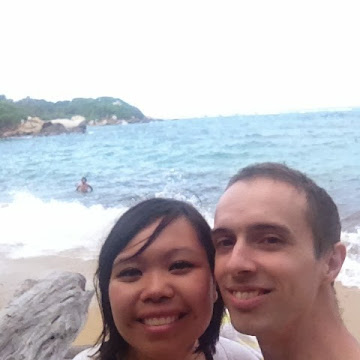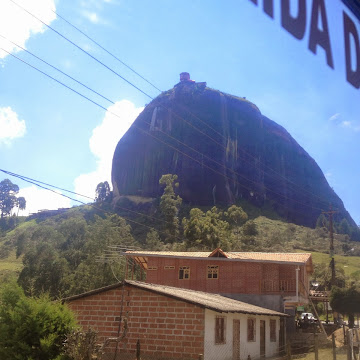Nous avons quitté Santa Marta, au nord de la Colombie pour nous diriger vers l'Équateur.
Prendre l'autobus était hors de question, cela nous aurait pris jusqu'à 3 jours et semble t'il que le chemin entre Cali et Pasto était fermé en raison de manifestations des autochtones. On aurait pu prendre un vol directement vers Quito mais les prix étaient prohibitifs pour un vol si court. On a donc décidé de prendre un vol vers Pasto, une ville colombienne proche de la frontière équatorienne. De là, on a pris un bus vers Ipiales, traversé la frontière a pied, continué vers Tulcán en taxi puis finalement pris un bus vers Quito. Plus long, mais moins cher.
Quito a beaucoup de charme. Malheureusement la première chose qui me vient à l'esprit en pensant à cette partie de notre voyage est la sécurité. On ne s'est jamais vraiment senti à l'aise dans la ville. Alors qu'en Colombie on peut voir l'armée et la police partout et où on se promenait, c'est tout l'inverse à Quito. Les blogues, guides touristiques, forums, racontent tous des histoires d'horreurs sur la ville. On n'a pas pris de chances et on s'est principalement promené en taxi. Mais même les taxis sont réputés peu fiables. On a pu remarquer beaucoup de faux-taxi dans la ville et les taxis officiels refusaient souvent d'utiliser leur compteur, il fallait donc s'obstiner sur le prix sans savoir si vraiment le taxi nous amenait vraiment là ou on voulait. Les guides recommandent d'appeler un taxi au téléphone plutôt que dans la rue mais on a essayé 4 compagnies différentes qui nous ont toutes raccrochées au nez à cause de notre espagnol imparfait. Il y a beaucoup d'endroits intéressants a voir dans la ville, mais l'idée de nous déplacer nous stressait à chaque fois et même si on habitait dans un des meilleurs quartiers, il était hors de question de sortir prendre une marche le soir.
Alors si vous êtes courageux, qu'est-ce qu'il y a à voir? Un peu comme Medellin, la ville est construite dans une vallée, entourée de montagne. C'est un volcan qui surplombe la ville. On peut monter dans les montagnes en téléphérique et c'est un endroit génial. Pour la ville elle même, on a vu le centre historique, le "museo de la ciudad" (qui parle de l'histoire de la ville) et la "capilla del hombre" (qui présente des oeuvres d'un peintre local très reconnu Guayasamìn). Le parc urbain Carolina est un des parcs les plus divertissants que j'ai pu voir, même davantage que Central Park à New York. En autobus, c'est facile de se rendre un peu au nord de la ville, à Mitad del Mundo. C'est l'endroit touristique où on peut voir la ligne de démarcation entre l'hémisphère Nord et l'hémisphère Sud. Ils ont seulement découvert avec l'arrivée des GPS il y'a quelques années que la ligne et le monument sont en fait construit 200 mètres au Sud du véritable Équateur. Il y a un petit musée qui est davantage proche de la ligne de démarcation qui y présente les tests classiques pour prouver qu'on est bel et bien au centre du monde (dur à a dire si c'est vrai ou truqué); comme le test sur le sens du tourbillon de l'eau quand elle coule dans un évier.
Je crois que le vrai charme de l'Équateur se retrouve dans les villes et régions en dehors de Quito. C'est beaucoup plus calme, plus sécuritaire, très bon marché et les gens y sont aussi beaucoup plus sympathiques. On n'avait pas beaucoup de temps mais on a passé une journée à Mindo, à 2 heures au Nord de la ville. On a fait du zip-line (arbre en arbre), une visite d'une fabrique de chocolats ainsi qu'un tour génial d'une réserve de papillons (que l'on pouvait nourrir de nos mains!). La ville regorge de d'autres attractions comme l'observation d'oiseaux, descente en rafting, escalade dans une chute, etc. C'est vraiment une place fabuleuse qui nous a réconciliée avec le pays.
Comme on veut prendre le temps un jour de retourner et voir les Îles Galapagos, on en profitera surement pour voir d'autres petites villes comme Mindo à travers le pays. Quito, on essaiera d'éviter!
Malgré tout, on a bien terminé notre voyage et on est content de retourner au pays sans mauvaise mésaventure. Ces 6 semaines de voyages ont vraiment bien été et notre but de voyage d'améliorer notre espagnol a été réalisé. On va d'ailleurs continuer par Skype des cours avec notre professeur de Medellin
À bientôt!
 |
| Toutes les photos d'Equateur |
--------------------------------------
We left Santa Marta in Colombia to head to Ecuador for the last leg of our trip.
Taking a bus from the north of Colombia to Quito would have taken us close to 3 days, so we decided to avoid that option. Apparently, the road from Cali to Pasto in Colombia was closed due to demonstrations from aboriginal groups, which would have prevented us from doing that anyway. There were flights available to fly directly to Quito but the high cost made it not feasible for us. So instead, we flew to Pasto, a colombian city close to the Ecuador border. From there, we took a bus to Ipiales, a border town. We crossed the border on foot and took a cab to Tulcán. From there, we got a bus to Quito. Much longer than a direct flight but also much cheaper.
Quito has a lot of charm but this fact can quickly be forgotten due to one major concern: security. We never really felt comfortable or at ease in that city. While you can see the army and the police literally everywhere in Colombia, it's quite the opposite in Quito. All the blogs, guides & forums we read shared an enormous amount of horror stories about safety in the city. And it's difficult to avoid it. We mostly cabbed all around the city (its cheap as well) to avoid walking in neighbourhoods we did not know, but cabs are hardly safer or convenient. We saw lots of fake cabs around and the official ones often refuse to use their taxi-meter to use the legal rate. So instead you have to bargain the price of rides to places you don't know and you are never sure anyway if the cab driver will bring you where he says he will bring you. Guide books recommend to call taxis on the phone. However, we called 4 distinct companies and they all hung up on us, I guess because our Spanish wasn't perfect and they couldn't understand everything. There's lots of nice sites to visit in the city but we felted stressed every time we had to move. Even if our Airbnb host was in a good neighbourhood, it was out of the question to take a walk at night.
So, if you are courageous, what can you visit? A bit like Medellin, the city is built in a valley around different mountains. There's an actual volcano on the side of the city. You can go up the mountain with a cable car and have an amazing view of the city, which we did. We also visited the historic center, the "museo de la ciudad" (that presents the history of the city) and the "Capilla del Hombre" (that shows the work of a famous local painter named Guayasamìn). The park named Carolina is one of the most entertaining park to spend time in that I've seen, seems even better than Central Park in New-York. It's easy to take the bus and go North to a nearby town called Mitad del Mundo (center of the world). It's a popular touristic destination where you can see the line that separates the northern hemisphere from the southern one. It's only few years ago when GPS were launched that they realized that they built the monument and traced the line at the wrong spot (200 meters South), which doesn't seem to bother them too much. There's another museum actually located closer to the line that shows different scientific experiments to prove that we are definitely located on the equatorial line. It's hard to know if it's real or fake but it's definitely interesting.
The real charm of Ecuador can be found in the other towns and regions that are outside of Quito. It's much more calm, safe, cheap and the people are much more friendly. We didn't have time to see a lot of those places so we chose to go to Mindo, 2 hours North of Quito. We had an excellent day doing zip-lining, visiting a chocolate factory and experienced a butterfly reserve where we could feed the butterflies from our hands. There's tons of other things to do in that town, such as rock climbing inside a waterfall, rafting, bird watching, etc. This visit reconciled us with the good side of Ecuador.
Since we want to come back one day to visit the Galapagos Island, we will probably end up visiting other towns in the country and do our best to avoid Quito.
We still ended up finishing our trip on a good note, without any issues. We are very happy of our trip and the 6 weeks of traveling were definitely worth it. We improved our Spanish a lot, which was an objective we had. We will be continuing classes with our spanish teacher from Medellin over internet.
We don't know where or when our next trip will be, but there will be another one for sure!
À bientôt!
 |
| All pictures from Ecuador |











